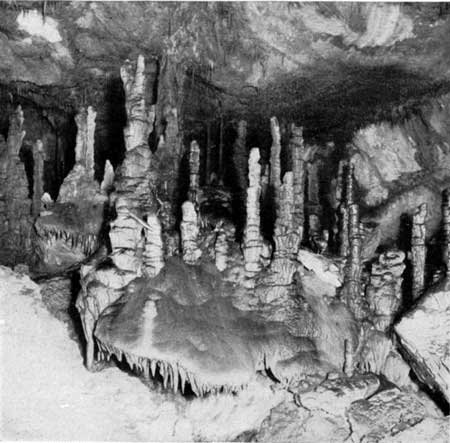![]()
MENU
|
Glimpses of Our National Monuments
LEWIS AND CLARK CAVERN |

Stalagmites in Lewis and Clark Cavern.
Photo by D. B. Church. Courtesy National Geographic Society.
The Lewis and Clark Cavern National Monument was established May 11, 1908, to preserve the limestone cave discovered in 1895 by D. A. Morrison, of Whitehall, Mont. It was so named because it overlooks, for a distance of over 50 miles, the trail of Lewis and Clark along the Jefferson River. At the time the monument was established the land reserved was unsurveyed and its location within the section, township, and range therefore not conclusively determined. After the survey of the land another presidential proclamation, dated May 16, 1911, was issued definitely delimiting the reservation. The total area of the monument is 160 acres.
The entrance to the cavern is about 1.300 feet above the river and about 500 feet below the rim of Cave Mountain. The general appearance of the cave is that of a fissure in a steeply inclined bed of limestone. Its maximum measurements are 600 feet long and 400 feet deep, but its numerous passages and rooms make it appear miles in extent rather than hundreds of feet.
The walls of the cave are decorated with marvelous stalactites and the floor with corresponding stalagmites. Huge fragments of limestone, some as big as the ordinary house room, have fallen from the roof in many places. In places the stalactites are found in terraces; a fringe of delicately carved forms, swelling at different levels, gives the appearance of cascades. Many of the stalagmite columns, encircled by horizontal rings with pendent stalactites, are superbly beautiful. All manner of curious drip formations add to the wild beauty of the cave. Eight or ten chambers have been explored, the largest of these being 105 by 135 feet and 100 feet high. From the main entrance a stairway leads irregularly down about 175 feet and then small tortuous passages, opening into the chambers, and ladders, carry the venturesome visitor into the depths.
The Lewis and Clark Cavern is located in Montana about 45 miles northeast of Butte, and about 60 miles as the crow flies north west of the northwest corner of Yellowstone National Park. It is situated at a point about 5 miles from the popular transcontinental highway known as the Yellowstone Trail, near Cardwell and about 14 miles from Whitehall on the Northern Pacific Railroad. After leaving the Yellowstone Trail a poor road ascends part way up the mountain. A trail then leads to the cave entrance requiring a climb of about 45 minutes.
The cave has been closed to the public for several years on account of vandalism and lack of funds to put in a lighting system and ranger protection.
|
|
Last Modified: Thurs, Oct 19 2000 10:00:00 pm PDT
glimpses2/glimpses17.htm

 Top
Top